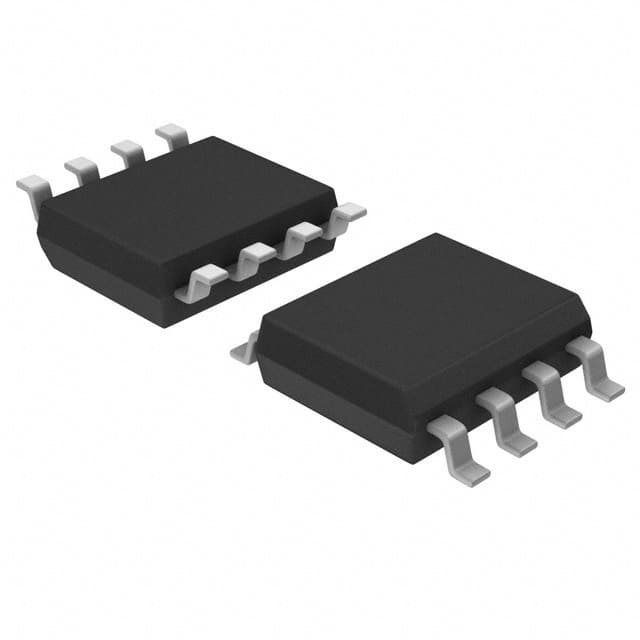74LVC2G125DCTRE4
Basic Information Overview
- Category: Integrated Circuit (IC)
- Use: Buffer/Driver
- Characteristics: Low-voltage, dual-gate, non-inverting buffer/driver
- Package: DCT (Dual Flat No-Lead) package
- Essence: Provides voltage level shifting and signal buffering capabilities
- Packaging/Quantity: Available in tape and reel packaging, with a quantity of 3000 units per reel
Specifications
- Supply Voltage Range: 1.65V to 5.5V
- High-Level Input Voltage: 0.7 x VCC
- Low-Level Input Voltage: 0.3 x VCC
- Output Drive Capability: ±24mA
- Propagation Delay: 3.8ns (typical)
- Operating Temperature Range: -40°C to +85°C
Detailed Pin Configuration
The 74LVC2G125DCTRE4 IC has the following pin configuration:
___________
OE --| |-- VCC
AIN1 --| |-- BOUT1
AIN2 --| |-- BOUT2
GND --| |-- OE#
|___________|
Functional Features
- Dual-gate design allows for independent control of each gate
- Non-inverting buffer/driver provides signal amplification without changing its logic state
- Supports bidirectional data flow
- Wide supply voltage range enables compatibility with various systems
- Fast propagation delay ensures quick response time
Advantages
- Small form factor and low power consumption make it suitable for portable devices
- High output drive capability allows for driving capacitive loads
- Wide operating temperature range ensures reliability in different environments
- Dual-gate design provides flexibility in controlling multiple signals
Disadvantages
- Limited output current may not be suitable for high-power applications
- Non-inverting nature restricts its use in certain circuit configurations
Working Principles
The 74LVC2G125DCTRE4 is a dual-gate buffer/driver IC that operates as a voltage level shifter and signal amplifier. It takes input signals from the AIN1 and AIN2 pins and provides amplified outputs at the BOUT1 and BOUT2 pins. The OE (Output Enable) pin controls the output state, allowing the user to enable or disable the buffer/driver.
Detailed Application Field Plans
The 74LVC2G125DCTRE4 IC finds applications in various fields, including: 1. Communication systems: Signal buffering and level shifting in data transmission circuits. 2. Industrial automation: Interface between different voltage domains in control systems. 3. Automotive electronics: Signal amplification and level conversion in automotive modules. 4. Consumer electronics: Voltage level translation in portable devices and audio/video equipment. 5. IoT devices: Signal buffering and voltage level shifting in sensor interfaces.
Detailed and Complete Alternative Models
Some alternative models to the 74LVC2G125DCTRE4 IC include: - SN74LVC2G125DCUR - MC74LVC2G125DTG - TC7SZ125FU
These alternatives offer similar functionality and can be used as replacements based on specific requirements.
Word count: 346 words
Lista 10 Vanliga frågor och svar relaterade till tillämpningen av 74LVC2G125DCTRE4 i tekniska lösningar
Sure! Here are 10 common questions and answers related to the application of 74LVC2G125DCTRE4 in technical solutions:
1. What is the 74LVC2G125DCTRE4? The 74LVC2G125DCTRE4 is a dual bus buffer gate with three-state outputs, designed for low-voltage (1.65V to 5.5V) applications.
2. What is the purpose of the 74LVC2G125DCTRE4? The purpose of this IC is to provide buffering and level shifting capabilities for digital signals in various electronic circuits.
3. What are the key features of the 74LVC2G125DCTRE4? Some key features include low power consumption, wide operating voltage range, high-speed operation, and compatibility with both CMOS and TTL logic levels.
4. What is the maximum operating frequency of the 74LVC2G125DCTRE4? The maximum operating frequency of this IC is typically around 400 MHz.
5. Can the 74LVC2G125DCTRE4 be used as a bidirectional buffer? No, the 74LVC2G125DCTRE4 is a unidirectional buffer and cannot be used for bidirectional signal transmission.
6. What is the output drive strength of the 74LVC2G125DCTRE4? The output drive strength is typically 24 mA, allowing it to drive moderately capacitive loads.
7. Is the 74LVC2G125DCTRE4 suitable for voltage translation applications? Yes, the 74LVC2G125DCTRE4 can be used for voltage translation between different logic levels, making it useful in mixed-voltage systems.
8. What is the power supply voltage range for the 74LVC2G125DCTRE4? The power supply voltage range is from 1.65V to 5.5V, making it compatible with a wide range of digital systems.
9. Can the 74LVC2G125DCTRE4 tolerate overvoltage on its inputs? No, this IC is not designed to tolerate overvoltage on its inputs. It is recommended to use external protection circuitry if there is a risk of overvoltage.
10. What is the package type of the 74LVC2G125DCTRE4? The 74LVC2G125DCTRE4 is available in a small SOT-23-8 package, which is suitable for space-constrained applications.
Please note that these answers are general and may vary depending on the specific datasheet and application requirements.


